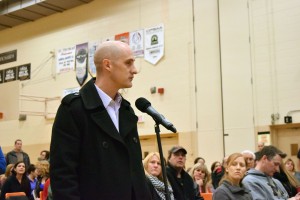Communities fear schools at risk

Amherstburg, Ont. Jason Lavigne, a town councilor for Amherstburg, questions the GECDSB on how they evaluate the schools in the community on Jan. 29, 2015. (Photo by Johnathan Hutton)
By: Johnathan Hutton
Tensions ran high at the Greater Essex County District School Board’s Program and Accommodation Review Committee’s first meeting.
It was a tense atmosphere at General Amherst Secondary School when members of the community filled the high school’s gym to hear how the public board would evaluate their school and if it was on the chopping block.
The meeting is the first of four to be held regarding the future of General Amherst, Western, Harrow and Kingsville secondary schools. The committee will also evaluate Harrow Public School and then submit a report to the GECDSB’s board of trustees on their recommendations.
Todd Awender, superintendent of education and accommodations for the school board, explained why these schools in particular are being evaluated.
“These five schools have been chosen to be evaluated because as a whole, they make up for 25 per cent of the empty space of the 71 buildings acting as schools,” said Awender. “Enrollment projections are to remain low for the next 20 years and we feel that the current situation is unsustainable. Renewal needs are also a factor with a combined total to fix each school being around $40 million.”
One student who attended Western Secondary and General Amherst said it is worth the money to keep the schools open.
“ I feel that Western especially is a school that shouldn’t be closed down,” said Kayla Benneteau, 21. “It is a school where kids can go and not be judged and the staff there doeseverything they can to help with students learning needs. You feel welcome and you fit in there.”
The next meetings are all scheduled on the same day as council meetings for Harrow, Essex and LaSalle. Jason Lavigne, a town councillor for Amherstburg, believes the school board should have scheduled the meetings so that councillors could be involved. He believes it is crucial the school board be more involved with the community in their decision-making process.
“General Amherst is the life blood of our community and it will affect everything we as a council do over the next four years … I hope they hear us loud and clear that we need to be a part of this process,” said Lavigne.
The committee, which is made up of the principal of each school at risk, four community representatives and a staff member from each school, will present a report to the board of directors. They are expected to decide what to do with the schools by next year.
Awender said they have not decided to shut down any schools yet as a result of the committee findings, but they are “keeping an open mind about everything.”


